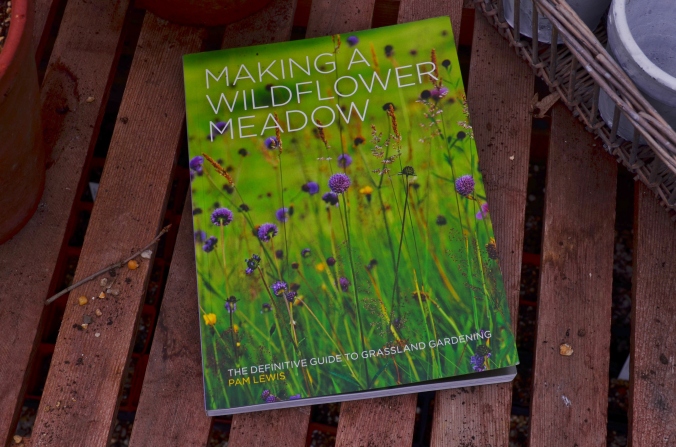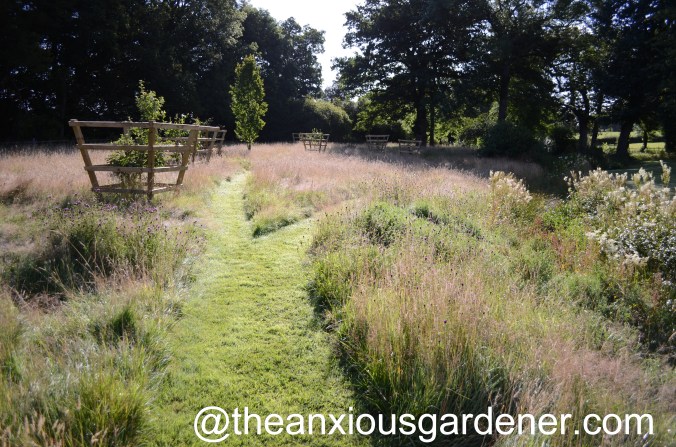I try to keep only a sensible number of gardening books – really I do. I’ve even given some away to charity … once or twice. But occasionally I’m offered a book to review and my resolve shrivels.
‘Making a Wildflower Meadow: The Definitive Guide To Grassland Gardening‘ by Pam Lewis was one of those books; one I needed to have. My pride and joy at the Priory is an acre of meadow that I’ve developed over the past few years and it was very useful, at last, to read detailed advice from an expert. I had carried out plenty of research but I hadn’t read an in-depth guide, cover to cover, before. Some things I knew. For instance, I knew that ideally I should have scraped off the top soil to reduce the ground’s fertility and then sown wildflower seed – but I had neither the funds nor the inclination to do so on such a big site. Pam’s book has reassured me that, given the flower species that have sprung up since I stopped weekly mowing (including common spotted orchids, grass vetchling and birdsfoot trefoil), scraping wasn’t really necessary with the conditions I’d inherited. Indeed, it seems from the book that the soil conditions for my meadow are pretty perfect. So that’s nice to know.
Some of Pam’s tips wouldn’t work at the Priory. For example, she suggests mowing a different layout of paths each year so that fresh strips are close-mown throughout the season. But as I have planted hundreds of bulbs in the areas between my paths and I don’t want to cut those fritillaries, camassias and daffodils in their prime, my path network must remain static.
I’m fascinated by the Priory meadow and its slow development year on year; a steady increase in flower numbers and variety; an exponential increase in insects. Pam started making her own traditional English flower meadows at Sticky Wicket, Dorset twenty years ago and has guided many others to create their own. Her knowledge and experience is extensive; her enthusiasm infectious.
The book is beautifully illustrated, very readable and has detailed sections on plants, wildlife and soil conditions, as well as information on creating, maintaining and improving flowery grassland month by month, year by year. Of course, not everyone has the space to create meadows on an acre or more plot but actually the book is specifically written for small landowners, gardeners and conservationists. In addition to two large paddocks, Pam also has several patches of small ‘meadow’ – just a meter or two square.
As do I. My ‘mini-meadows’ are areas of lawn where I planted daffodils. Originally I left them uncut until the daff foliage had died back … but quickly learnt to leave them be until late summer. I do nothing other than that. The result is almost a dozen patches of fine grass heads, self-heal, knapweed, eyebright and clovers – even cowslips. I added none of these plants which, of course, bees and butterflies love. How easy is that?
Pam writes that if only 10% of garden area in this country is converted to meadow grassland, we could re-instate 10 000 acres of wildflower and butterfly rich habitat. Since we have lost 98% of flower-meadow in the past 60 years, 10 000 acres would be a tremendous boon for our beleaguered native flowers and insects. Pam also bemoans how difficult it is to find contractors willing to cut smaller meadows. Well, not in my area of East Sussex. Sam, my mowing man, is exceptionally busy in August and September and I have to book him well in advance (with an eye on the weather). He tells me he has never been busier; cutting an increasing number of newly made, relatively small meadows. Great news for Sam and for Sussex, but also great news that meadows are very much in vogue and so popular. It’s about time.
‘Making a Wildflower Meadow‘ first appeared in 2003 but Frances Lincoln has just published a new edition for £14.99. If you’d like the chance to win a copy (not mine!) here’s all you need to do:
leave a comment below saying that you wish to enter
and
(if you don’t do so already) follow ‘The Anxious Gardener’ blog; follow me on Twitter or like The Anxious Gardener Facebook page. All three follow buttons are top right of this page. (You can also enter by simply following me on twitter and re-tweeting this post or liking my page and leaving a comment on Facebook).
Please note that you must have a UK postal address to enter … or the use of one. (The book can only be posted within the UK).
The closing date is midnight on Friday 27th February 2015.
I’ll draw a name from my
contact the winner and add the result to the bottom of this post.
Good luck!
There will be another book draw soon.
oooOOOooo
To order ‘Making A Wildflower Meadow’ at the discounted price of £12.00 including p&p* (RRP: £14.99) telephone 01903 828503 or email mailorders@lbsltd.co.uk and quote the offer code APG282.
*UK ONLY – Please add £2.50 if ordering from overseas.
oooOOOooo
The competition is now closed. Thanks to everyone for taking part on the blog, Facebook and Twitter. The winner is Jennifer Hawkin. Congratulations.





I bought this book a few months ago – fantastic. Aiming to work some wild flower magic in my meadow. This year I am getting the grass down by covering and hopefully in Spring it will be dead enough to rake out and move the topsoil to future planting beds. Then I can sow the seed. My local bees are agitating and I have a deadline to meet.
LikeLiked by 1 person
Good luck with all that, Judi. You have your work cut out. But the final result will be amazing, I’m sure. D
LikeLike
Would love to win a copy of this. I am trying to create a ‘pocket handkerchief’ size meadow to complement our organic garden and provide a rich nectar source for the insects in the garden. This book would be a great help to achieve what we see in our mind’s eye!
LikeLike
Good luck, Chriistine. D
LikeLike
That’s a lovely-looking book and I’d love to win a copy thanks.
LikeLike
Hi Vohn, name in the hat. D
LikeLike
Hi David, I would love a copy please. Your timing is perfect – we created a “new” bit of garden last year by building a wall at the front of what used to be a horrid slope onto the drive, and have built up the ground level behind the wall. It’s next to the fruit cage and I plan to make a small meadow, partly because it will look lovely and partly because it should attract pollinators.
Many thanks :}
LikeLike
Hi Jayne, sounds lovely. Good luck. D
LikeLike
this would be great for a wild flower garden I am developing in our village!
LikeLike
Good luck Jan.
LikeLike
I wish I could persuade the ‘maintenance’ gardeners (a team of council workers who turn up with hedge trimmers and mowers once a month) to leave the grass verges here alone.(But I can’t, that’s their job.) There’s a point in the spring when the grass is gorgeously covered in buttercups, daisies and other stuff I haven’t got a clue about. It looks wonderful but a scalping later and it’s all gone. Best moment last summer was seeing the areas that Hampstead Heath gardeners had left for meadows – it was stunning!
I think I need to read this book so that I can identify a few more plants. Pop my name into your hat, Dave, please. Fingers crossed!
LikeLike
Name popped, Caro. I thought, generally, councils are better at leaving verges unstrimmed. I pass several on my way to work which have a little flower sign erected on them that tells the contractors to leave alone. D
LikeLike
Just planning next steps for our patch… Would love a copy please 🙂
LikeLike
Look forward to seeing it, Jo. Good luck. Dave
LikeLike
I’d love to enter please. I’m planning on turning a section of our paddock into a wildflower meadow and this book would be great. Many thanks and I really enjoy reading your blog.
LikeLike
Thank you, Bumbleandyou and good luck. D
LikeLiked by 1 person
Ooh yes please! When we retire we’ll have a couple of acres to play with, and a meadow is high on the list of things to do…
LikeLike
Sounds idyllic Nick. Good luck.
LikeLike
Ooh yes please, I’d love to win this book. Have been thinking of making a wild flower meadow
for ages, this will inspire me to get started.
LikeLike
Hi Jennifer, name in the hat. D
LikeLike
Oh that’s a lovely idea! I’d love ideas to encourage more wildlife to the garden
LikeLike
I’ll enter you into the draw, Maxine. Good luck. D
LikeLike
“My ‘mini-meadows’ are areas of lawn where I planted daffodils. Originally I left them uncut until the daff foliage had died back … but quickly learnt to leave them be until late summer. I do nothing other than that”….this is the same scenario as ours but found the grass flopped big time late summer especially after a heavy downpour. What affect did a mow after daff dieback have on your meadow? 🍀 lucky four leaf clover for the book!
LikeLike
Hi Clare, I’ve found the trick is to cut the ‘patches’ before they get flattened. I get it wrong sometimes but generally you know when the best is over and its time to mow. Going over them with the ride-on on progressively lower cutting heights does do the trick – even on flattened grass. They do look messy to begin with after cutting but soon bounce back. Good luck with the draw. Dave
LikeLike
There is nothing finer than to see a wild flower meadow- unfortunately my garden is just too small but I do sow wild flowers in the borders – does that count?
LikeLike
Well, I think it does. Plenty of people sow meadow seed on prepared soil in small beds. Bees and butterflies will be just as grateful. D
LikeLike
I’d love to read the book! And a great excuse for not cutting the grass every week – every ones a winner! Please enter me! ( :
LikeLike
HI Sian, good reason for growing a meadow. Good luck. Dave
LikeLike
That’s a book I wouldn’t mind having! I’m sure your meadow making in the UK is a much different business but I agree it’s a worthwhile effort. My little three postage stamp sized meadow might just be my favorite spot in the garden, for all the reasons you already mention. Much better the first year when I let the entire back yard go, but neighbor relations are much better now that the meadow is smaller and the rest mowed or planted to something more interesting than turf.
LikeLike
Shame you can’t enter Frank but it sounds like you don’t need much help. Dave
LikeLike
Yes please Dave, I read an article on Sticky Wicket last year and have kept the article, can you put my name in the hat too.
LikeLike
Sorted, Julie.
LikeLike
Gosh, that early morning (?) light on the second photo is absolutely stunning. And to celebrate the fact that you have finished your cup of tea, I’d love to enter the book draw – thank you!
LikeLike
I can spend quite a lot of time just staring at the meadow in summer. And top points for noticing a change in photo. I might have another cup of tea very soon. Good luck. D
LikeLike
Would love a copy as it might stop husband and I procrastinating and arguing about the best way to turn our 1 acre paddock into a wildflower meadow
LikeLike
Hi Carole, I hope you win if only to stop arguments. D
LikeLike
My garden is a mini meadow, it rarely gets cut! It would be great to know the names of the flowers growing in it, I do know there is common spotted orchid.
LikeLike
Great to have orchids. I find they spring up quite randomly. Good luck. Dave
LikeLike